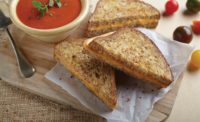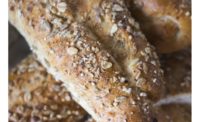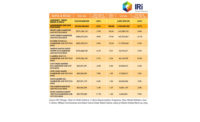Bakeries serving the buns and rolls segments of fresh bread have multiple opportunities to build sales by aligning with prevailing trends across retail and foodservice.
Overall, buns and rolls have remained rather flat for the 52 weeks ending July 15, 2018, per IRI, Chicago. The all other fresh rolls/buns/croissants segment grew 1.29 percent to $2.2 billion, while hamburger and hot dog buns was up 0.06 percent to $1.9 billion.
Campbell Soup Co. and its Pepperidge Farm brand saw the best performance across both segments for the year, up 6.39 percent to $127.7 million in all other fresh rolls/buns/croissants and growing 8.83 percent to $104.9 million in hamburger and hot dog buns.
King’s Hawaiian Bakery West also saw notable growth in all other fresh rolls/buns/croissants, up 5.07 percent to $487.7 million, while H&S Bakery grew 5.81 percent to $28.1 million.
In hamburger and hot dog buns, private label—the segment leader—grew 2.06 percent to $794.4 million. King’s Hawaiian grew 1.49 percent to $28.1 million, while Pan-O-Gold Baking Co. was up 1.5 percent to $28.0 million.
In foodservice, Datassential, Chicago, highlights an ongoing trend with brioche, now on 11.2 percent of menus for restaurants serving sandwiches, up 13 percent over the past year and up 97 percent over the past four years. And while potato rolls have only begun to penetrate sandwich menus, at 0.9 percent, Datassential reports 39 percent growth over the past year and 189 percent growth over the past four years.
Other bun and roll styles factoring into growth metrics at foodservice, per Datassential, include: gluten-free, at 2.9 percent menu penetration, up 17 percent over the past year and 79 percent over four years; “artisan,” at 2.6 percent penetration, up 7 percent over the past year and 28 percent over the past four years; and sourdough, at 13.5 percent penetration, up 5 percent over the past year and 9 percent over the past four years.
Sandwich trends
Bakers have felt a notable uptick in demand for brioche buns and rolls. “Brioche-type buns and rolls, far and away, command the most interest,” says George De Pasquale, founder and head baker, The Essential Baking Company, Seattle. “Almost all of our movement in foodservice buns and rolls are variations on the brioche theme.”
According to Tim Boote, marketing director, St Pierre, Manchester, England: “Initially, brioche was mostly available at fine dining and independent establishments. Today, we’re seeing it across other segments, especially in the fast-casual and casual dining space in the form of burger and sandwich buns.”
This increased exposure has familiarized Americans with brioche, fostering demand at retail, suggests Boote. He notes top sellers for St Pierre are its Brioche Rolls and Brioche Burger Buns. “Our St Pierre Brioche Sliders are another top-seller.” St Pierre also recently launched a Brioche Soft Baguette, designed to create hardier sandwiches like chicken Parmesan and meatball subs.
Buns and rolls made with ancient grains and indulgent flavor combinations, like aged Parmesan and roasted garlic, will complement the high-quality ingredients found in today’s upscale sandwiches, suggests Jeff Billig, vice president and general manager, Delavau Food Partners, Piscataway, NJ. He also suggests that globally inspired, more-niche offerings like spicy-sweet Swedish cardamom buns can appeal to diverse tastes.
Hawaiian-style sweet buns, pretzel buns and ciabatta rolls can help retailers and foodservice operators add pizzazz to their offerings, suggests Paul Bright, innovation manager, AB Mauri North America, St. Louis. “Hawaiian rolls continue to become increasingly popular for pulled pork sliders, while pretzel buns have a robust flavor and sturdy texture that stands up to the tallest of sandwich fixings. Ciabatta rolls can be used for paninis, or appetizers like bruschetta or garlic bread.”
Datassential notes that trends driving growth on today’s sandwich menus include authentic ethnic and globally inspired fusion offerings, including bánh mì (Vietnamese, typically on baguette), tartine (French, open-faced, typically on artisan bread, often toasted), croque monsieur (French, on standard pan or Pullman bread) and torta (Mexican, on white bolillo rolls, similar to French rolls/baguettes).
“With the U.S. market’s growing interest in brioche, Hawaiian-style rolls, Cuban and other Hispanic sandwich breads, organic breads, and other authentic and artisan-style varieties, there is plenty of room for reinvention and innovation, as long as bakeries remain strategically and tactically aligned with consumer needs,” says Cam Suárez-Bitár, marketing and public relations manager, Bellarise, Pasadena, CA.
Regional influences are also showing up on sandwich menus, notes Datassential, including Southern fried chicken and Nashville hot chicken sandwiches, as well as Louisiana po’ boys and New England lobster rolls.
Datassential also notes the mounting popularity of potato buns and rolls—one of the fastest-growing sandwich carriers in recent years. Major chains like Burger King, Bob Evans and Shake Shack have all released sandwiches on potato buns.
Sandwiches with diverse fillings featuring more sauces are starting to show up in QSR, notes Ken Skrzypiec, vice president, Eastern sales, Brolite Products, Bartlett, IL. “These items require a bun or roll that can hold up to the inclusions.”
Artisan interest
“Craft” sandwiches featuring artisan buns and rolls, along with premium meats and cheeses, are also on Datassential’s radar. McDonald’s, Pret a Manger, Arby’s, Quiznos and California Pizza Kitchen have all introduced sandwiches on “artisan” buns and rolls over the past year.
Artisan buns and rolls connect with a desire for authenticity, says Suárez-Bitár. “Their halo effect implies purity and a higher level of craftsmanship for a more-discerning U.S. consumer. We see artisan brioche, sourdough, Kaiser and pretzel formats, among others, as strong options for industrial bakeries looking to be top-of-mind with younger generations in the North American market.”
De Pasquale notes increased interest in multigrain buns and rolls, as well as specialty grains, like spelt and emmer wheat. “People seem to be less interested in the classic white, cottony burger buns and dinner rolls in favor of more-unique character and premium ingredients. People seem to want products that will add more to the meal.” This includes clean-label buns and rolls made with whole-grain, local, organic and/or non-GMO grains.
Retail shoppers are looking for variety, notes Skrzypiec. “Savory and sweet flavor notes are starting to make their way into the food chain. Multigrain rolls are still doing a good job, and the varieties are almost endless, with the grains, pulses and organic items, as well.” He also notes that clean label in foodservice is growing more important, with foodservice operations advertising their clean-label efforts.
“From organic gluten replacement and DATEM replacement to non-GMO dough-conditioning solutions and sugar replacement, custom clean-label enzyme solutions are the key,” says Suárez-Bitár. “Authentic, artisan buns and rolls can only be made with clean-label ingredients, and organic and non-GMO will continue to fuel innovation and reinvention in the category.”
But while clean label is undeniably on the rise, sensory enjoyment must still come first, notes Billig. He recommends solutions for bakers seeking to maintain softness and extend the shelf life of buns and rolls while simultaneously displacing the ingredients they seek to eliminate.
Consumers look for healthy, clean-label buns and rolls at both at the supermarket and when dining out, says Billig. “With this new standard, buns made with heart-healthy whole grains and without artificial preservatives will become more prevalent on menus.” Also, fortifying buns and rolls with nutritional benefits, like added calcium, could entice consumers to purchase what would otherwise be seen as an indulgence item, he suggests.
Bun and roll bakers need to offer functional and nutritional benefits to stand out on the shelf and menu, suggests Mark Stavro, senior director of marketing, Bunge North America, Chesterfield, MO. To meet this need, he recommends ancient and whole grains, including non-GMO and organic types, and ingredients to help meet high-fiber and traceability claims. He says clean-label functional corn flours can replace modified starches, gums and alginates.
Suárez-Bitár also suggests that U.S. consumers will likely pay a little more for a unique, flavorful, clean-label product or menu item. “As the X, Y and Z generations play a more-dominant role in the U.S. market, we’re seeing a sharper turn in interest toward buns and rolls inspired by artisan breads, street food, ethnic foods and on-the-go snacking.”
Snack-sized opportunities
Boote notes that St Pierre is seeing an increase of portion-controlled bun and roll products. “Not only are people snacking more, but they’re also more conscious of what they’re eating. Even if they’re on a diet, they may be more inclined to purchase rolls if they come in a smaller package. Smaller portion sizes also appeal to smaller households who may want to purchase rolls, but don’t necessary want so many.”
In August of this year, St Pierre introduced a Brioche Popover. “It’s a light, sweet brioche dough with a buttery crumb, flaky texture and creamy filling of vanilla, chocolate or cinnamon swirled throughout it,” says Boote. “We launched it as a two-pack to satisfy the growing snack trend.”
Snack-sized sandwiches draw great inspiration from global cuisine. Bakeries of all sizes are taking cues from street food and the creative fusion seen in the food truck sector, says Suárez-Bitár, citing examples like medianoche—similar to Cuban sandwiches—and South American arepas as on-the-go meals. He also suggests keeping an eye on small-format buns. “They will continue to appeal to younger generations whose penchant for carb-consciousness, quality and replacing meals with snacks matches their growing spending power.”
Datassential notes that arepas are on the rise on menus, commonly found on the appetizer menu at ethnic restaurants—but gaining traction on non-ethnic restaurants.
Dough for Venezuelan and Colombian arepas is made with precooked corn flour (harina de maíz precocida) and is unleavened. The dough is often griddled before splitting and stuffing with various sandwich fillings.
In many ways, arepas form a perfect vehicle for category growth—an unexplored bun/roll product format that’s easily gluten-free, with a strong ethnic culinary sensibility, that’s trending forward in foodservice, and fills a need for on-the-go snacking.
Traditional buns and rolls aren’t going anywhere soon, but any opportunity to spur incremental sales is worth exploring.








